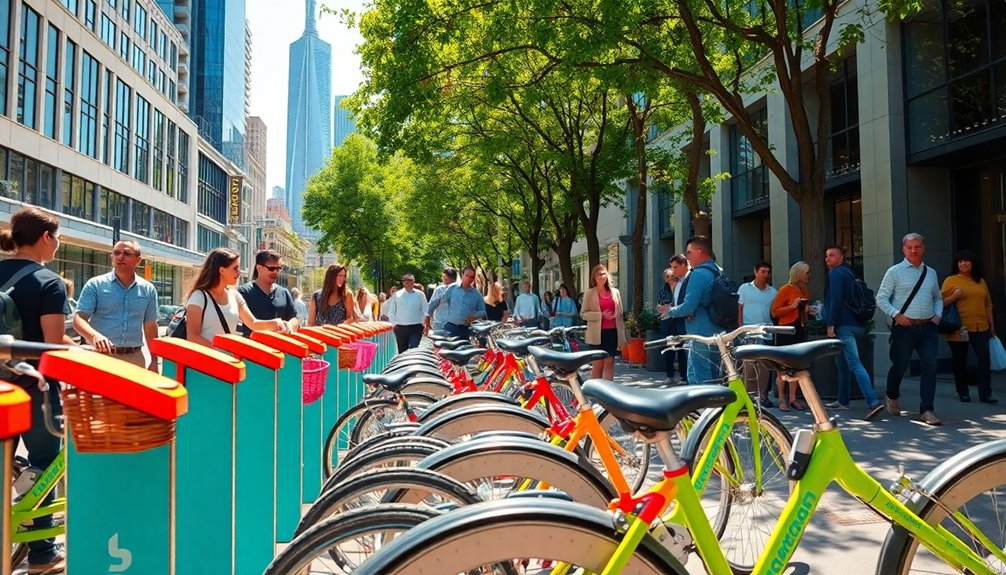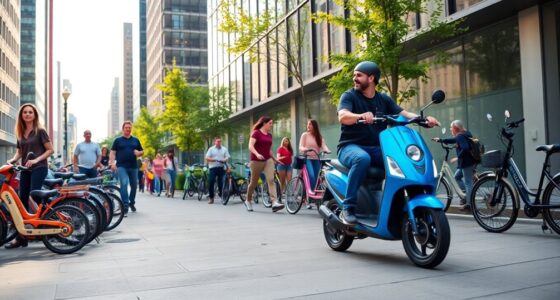City bike rentals and sharing programs are a great way to navigate urban spaces while promoting eco-friendly travel. You can choose between docked systems, which have designated stations, or dockless systems, giving you the flexibility to park anywhere. Successful smaller city programs, like Madison's B-cycle and Boulder's community-driven initiative, show how effective these systems can be. Check out the best practices for planning and implementing your own bikeshare program to ensure success and accessibility for all.
Key Takeaways
- Types of Systems: Understand the difference between docked and dockless bikeshare systems to choose the best option for your needs.
- Successful Examples: Learn from smaller cities like Madison and Chattanooga that have successfully implemented bikeshare programs.
- Planning Essentials: Conduct a feasibility study and demand analysis to determine the viability of a bikeshare program in your city.
- Equity and Accessibility: Ensure stations are placed in underserved areas and provide subsidized memberships to promote inclusivity.
- Financial Sustainability: Explore diverse revenue streams, including user fees and sponsorships, to maintain the bikeshare program's financial health.
Types of Bikeshare Systems

When considering your options for city bike rentals, it's important to understand the two main types of bikeshare systems: docked and dockless.
Docked systems require you to pick up and return bikes at designated stations, making them ideal for areas with high population density. You'll find kiosks for easy checkout in places like Paris and Mexico City.
Docked systems allow bike pickup and return at designated stations, perfect for densely populated areas like Paris and Mexico City.
On the other hand, dockless systems offer more flexibility since you can use a smartphone app to locate and unlock bikes without needing a specific station. You can park these bikes at bike racks or along sidewalks.
While dockless systems provide equitable access, they may face challenges like vandalism and theft.
Understanding these options helps you choose the best fit for your biking needs.
Successful Implementations in Smaller Cities
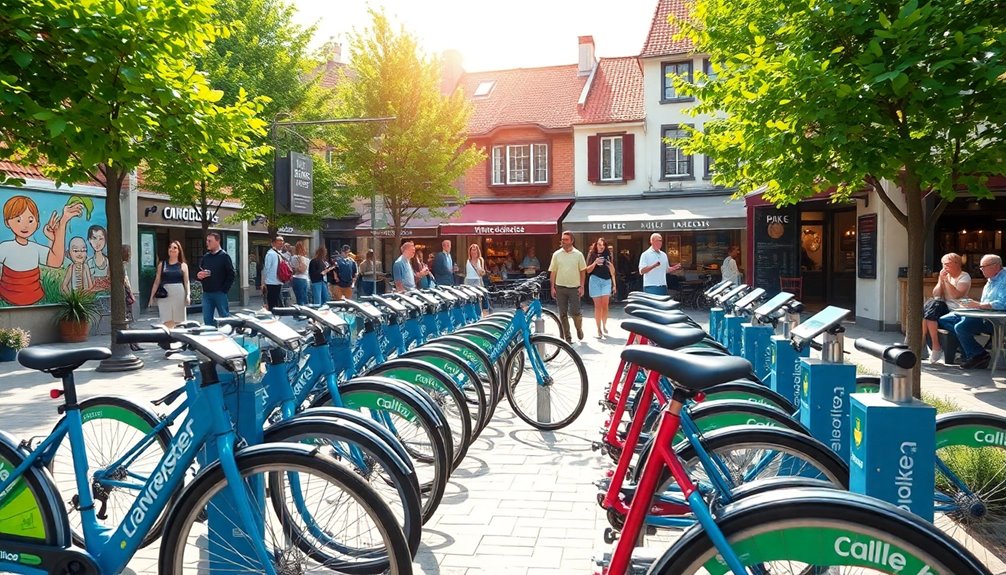
Many smaller cities have successfully launched bikeshare programs that cater to their unique needs and community dynamics. For instance, Madison, WI, features a thriving B-cycle program with 35 stations and 225 bikes, initially funded by Trek.
Chattanooga, TN, benefits from partnerships with local universities, offering 300 bikes across 32 stations. In Boulder, CO, community involvement drives a B-cycle system with 22 stations and 150 bikes.
Aspen's We-Cycle started with $250,000 and expanded to 51 docking stations with 284 bikes. Athens, OH, offers a Book-a-Bike Program through libraries, funded by a $17,000 grant.
These programs thrive on community support, strategic station placements, and cost-effectiveness, making them valuable transportation options for residents and visitors alike.
Planning and Implementing a Bikeshare Program

Building on the successes seen in smaller cities, planning and implementing a bikeshare program requires careful consideration of various factors to ensure its effectiveness.
Start with a feasibility study to analyze key parameters and financial viability. Conduct a demand analysis to identify potential users, focusing on population density and transit networks.
Begin with a feasibility study to assess financial viability and conduct a demand analysis targeting potential users.
Establish a system coverage area in high-demand zones, targeting a bike-to-resident ratio of 10–30 bikes per 1,000 residents. Ensure station density is between 10–16 stations per km² for convenience.
Develop revenue models through subscriptions and casual rentals, while exploring funding mechanisms. Engage the community through outreach to promote ridership.
Finally, implement the system in phases for efficient rollout and management.
Ensuring Equity and Accessibility
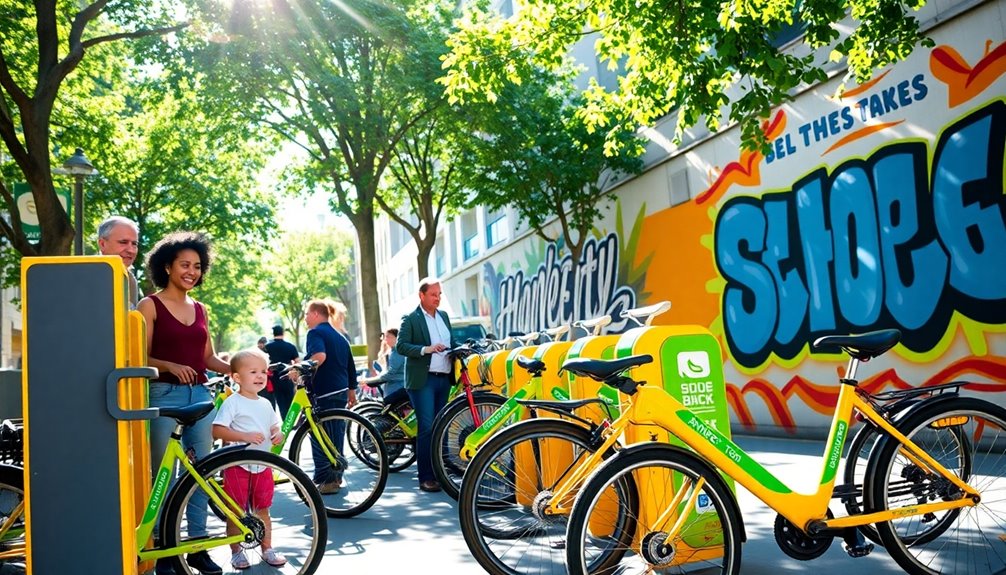
Ensuring equity and accessibility in bike share programs is crucial for promoting inclusive urban mobility, especially as cities strive to create sustainable transportation options for all residents.
Many bike share systems face inequitable distribution, particularly in low-income and minority neighborhoods. To address this, you can advocate for station placement in underserved areas and support subsidized memberships for those who need them.
Emphasizing diverse payment options and integrating bike share with public transit can further enhance accessibility. Engaging with local communities through outreach and education can break down cultural barriers.
Lastly, implementing equity policies and regularly monitoring access metrics will ensure that bike share systems serve all demographics fairly, fostering a truly inclusive environment for everyone.
Technological and Infrastructure Considerations

As cities embrace bike share programs, leveraging technology and infrastructure becomes essential for their success.
You'll find automated docking systems making bike rentals quick and efficient, while smart card technology simplifies payments. Real-time data integration allows you to check bike availability and plan your routes seamlessly.
Strategically placed stations near public transport and in high-density areas enhance accessibility and encourage usage. Designing these stations with user-friendly interfaces and multilingual support ensures everyone can navigate them easily.
Maintenance is crucial, so expect regular upkeep of the bikes and charging options for e-bikes.
Financial Models for Sustainability
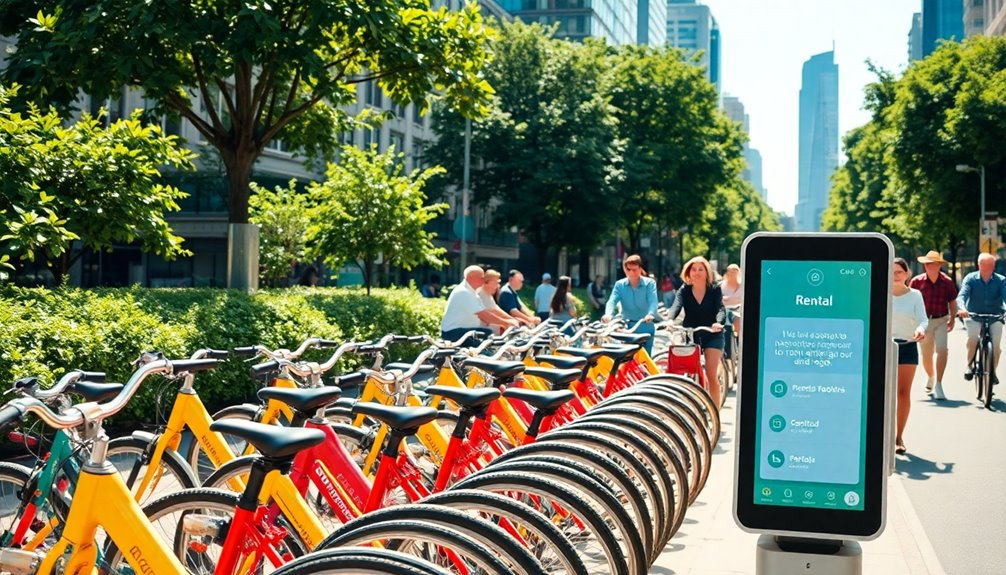
While developing financial models for bike-sharing programs, it's crucial to explore diverse revenue streams and cost structures to ensure long-term sustainability. You can generate income through user fees, government funding, and advertising.
Exploring various revenue streams and cost structures is essential for the long-term sustainability of bike-sharing programs.
Initial capital costs include bicycles and stations, while ongoing operating expenses cover maintenance and staffing. Conducting a financial feasibility analysis helps you estimate costs against financing options to maintain viability.
Investing in reusable and recyclable materials enhances sustainability. Implementing climate-neutral operations and seeking government support can further contribute to a sustainable business model. Additionally, embracing technology advancements and forming partnerships for corporate sponsorship can boost your revenue. By focusing on these areas, you'll create a financially sound bike-sharing program that supports community growth and environmental goals.
Furthermore, understanding the average cost ranges of operating similar systems can help in making informed financial decisions.
Environmental Benefits of Bikeshare Programs

Bike-share programs offer significant environmental benefits that extend beyond simply providing a convenient mode of transportation. By substituting car trips with biking, you help reduce greenhouse gas emissions, as seen with New York's Citi Bike saving over 30,000 tons of CO2.
These programs also decrease air pollutants like NOx, contributing to cleaner air quality. With no fuel consumption, cycling cuts down energy use and helps relieve traffic congestion, resulting in further emissions reduction.
Many systems even utilize solar power for charging e-bikes, promoting sustainable energy. By encouraging a shift towards eco-friendly commuting, bike shares support urban planning that prioritizes sustainable transportation, making cities greener and more livable for everyone.
Community Engagement and Support
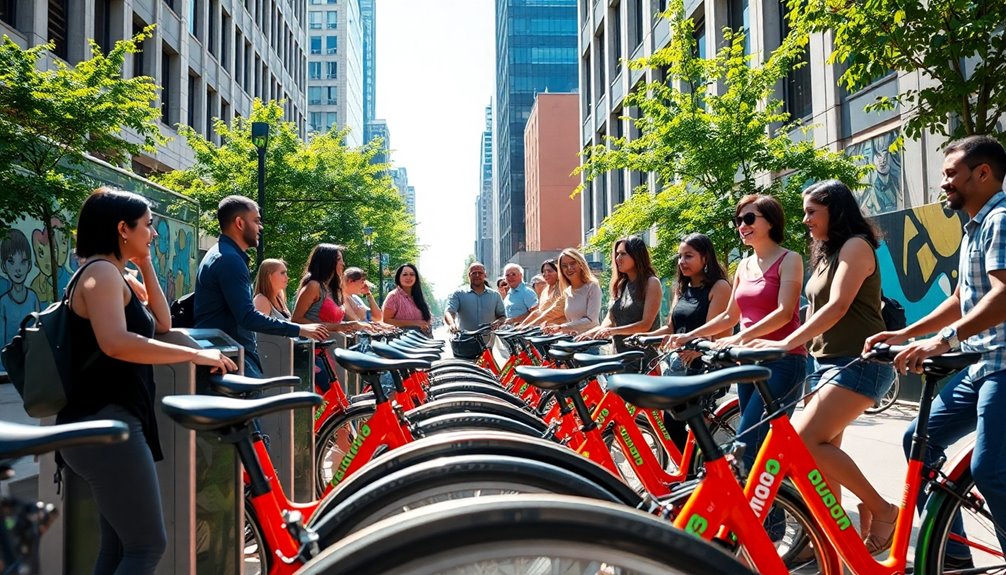
Community engagement is vital for the success of bike-sharing programs, ensuring that local voices are heard and considered in planning and operations. By actively involving stakeholders, you can tailor services to meet community needs.
Attend community events to gather feedback, and create partnerships with local organizations to strengthen support. Organizing community rides fosters participation and builds connections among riders.
Implement adaptive programs for greater accessibility and consider reduced fare options for low-income residents. Regular feedback mechanisms, like surveys, help you continuously improve the program.
With targeted outreach and a focus on equity, you can create an inclusive bike-sharing system that benefits everyone in the community, making cycling a viable transportation option for all.
Frequently Asked Questions
How Do I Register for a Bikeshare Program?
To register for a bikeshare program, you'll start by visiting their website or a local station.
You'll need to create an account, providing your contact info and payment details. Choose a membership option that suits your needs, whether it's daily, weekly, or annual.
Once registered, you'll access bikes using your membership card or a password.
Remember, the first half hour is usually free, with fees increasing for longer rides.
Enjoy cycling!
What Are the Age Requirements for Using Bikeshare Bikes?
To use bikeshare bikes, you generally need to be at least 16 years old.
If you're under 18, you might require parental consent, as a parent usually needs to buy your pass.
When checking out a bike with a credit card, you'll likely need to be 18 or older.
Make sure you're aware of any age verification processes during registration to ensure a smooth experience.
Always follow local traffic laws while riding.
Can I Ride Bikeshare Bikes Outside Designated Areas?
When it comes to riding bikeshare bikes, you can often venture outside designated areas.
However, remember: "A penny saved is a penny earned."
While exploring, you're responsible for returning the bike to a hub within the service area to avoid penalties. Riding outside may also incur extra fees if you don't return it properly.
Always follow local traffic laws and ensure you park responsibly at the end of your trip.
What Should I Do if I Encounter a Bike Malfunction?
If you encounter a bike malfunction, don't panic. First, stop riding and assess the situation.
Take note of the issue, and if possible, snap some photos for documentation. Report the malfunction to the bike share service immediately, using their contact information.
Avoid riding the bike any further to ensure your safety and prevent additional problems. If necessary, consider alternative transportation options while waiting for assistance or a replacement bike.
Are There Penalties for Late Bike Returns?
Yes, there are penalties for late bike returns.
If you return a bike late, you'll often face additional rental fees based on how long you delay. For example, a short delay could cost you a full day's rental.
If you don't return the bike within a set timeframe, it might be considered lost, leading to charges for its full retail value.
Staying aware of the policies can help you avoid these financial burdens.
Conclusion
So, if you thought biking's just for the elite or the fitness fanatics, think again! Bikeshare programs are here to prove you wrong. They're not only eco-friendly and wallet-friendly but also a community builder, bringing folks together in the most unexpected ways. By embracing these systems, you're not just getting from point A to B; you're joining a movement that's as inclusive as it is fun. Who knew cycling could be the great equalizer?
